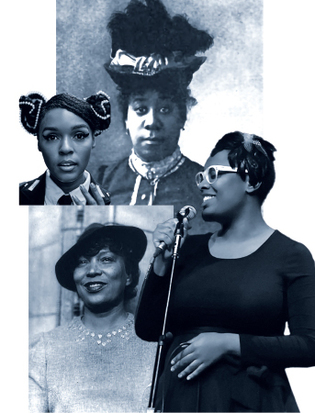
Collage: Jeanine Dunn. Images: Wikimedia Commons.
In her new book “Liner Notes,” Daphne Brooks revisits the place of Black women in music history. (Clockwise from top left: Janelle Monáe, Pauline Hopkins, Cécile McLorin Salvant, and Zora Neale Hurston.)
View full image
For decades, music critics have tended to marginalize and undervalue the musicianship of Black women. Now Daphne A. Brooks, a professor of music and African American studies, has proved those critics wrong. Her latest book, Liner Notes for the Revolution (Harvard), is a radical rewrite of twentieth- and twenty-first-century music history.
Liner Notes recovers the voices of Black women as theorists of sound. (The title references the explanatory texts on record albums and CD booklets.) Starting from what she considers the first instance of Black feminist music criticism—in Pauline Hopkins’s 1903 novel Of One Blood—and moving all the way up to Beyoncé’s seminal visual album Lemonade (2016), Brooks tells “a twofold story of how an array of daring Black women artists engaged with historical memory and fragments of Black folks’ sociocultural past through sound, and of how these same artists innovated their own distinct and innovative modes of critical practice within Black sound.”
To tell this story, Brooks brings together counterculture feminist music criticism of the 1960s and ’70s and the long tradition of Black studies scholarship. She highlights the work of Cynthia Dagnal-Myron, Lorraine O’Grady, and Phyl Garland, whose groundbreaking music criticism and coverage of early performances by artists such as Bruce Springsteen and Bob Marley is rarely remembered as central to the field. Brooks also calls attention to other Black women who were writing about music: for instance, she foregrounds Zora Neale Hurston’s years traveling the country as a singer and ethnographer.
With the critical tools gleaned from these intellectuals, Brooks takes a deep dive into the personal archives of a number of musicians, seeking to understand their sound in the context of their personal and political lives: “How did it feel? What did they want? Why did they go, rather than where?” She applies this approach, for example, to the career of a little-known Depression-era blues duo, Geeshie Wiley and L. V. (“Elvie”) Thomas, recovering the intentions behind their sound.
Proceeding through the book, a reader begins to feel that Liner Notes is something more than a study of artists and critics. Brooks seems to agree. “Above all else,” she writes, “I take seriously the centrality of sound in Black women’s lives as a foundation for developing and sustaining pivotal, profoundly meaningful world-making sociocultural networks and forms of intimacy with one another.”
 loading
loading